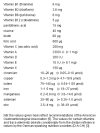Water, electrolytes, vitamins and trace elements - Guidelines on Parenteral Nutrition, Chapter 7
- PMID: 20049067
- PMCID: PMC2795367
- DOI: 10.3205/000080
Water, electrolytes, vitamins and trace elements - Guidelines on Parenteral Nutrition, Chapter 7
Abstract
A close cooperation between medical teams is necessary when calculating the fluid intake of parenterally fed patients. Fluids supplied parenterally, orally and enterally, other infusions, and additional fluid losses (e.g. diarrhea) must be considered. Targeted diagnostic monitoring (volume status) is required in patients with disturbed water or electrolyte balance. Fluid requirements of adults with normal hydration status is approximately 30-40 ml/kg body weight/d, but fluid needs usually increase during fever. Serum electrolyte concentrations should be determined prior to PN, and patients with normal fluid and electrolyte balance should receive intakes follwing standard recommendations with PN. Additional requirements should usually be administered via separate infusion pumps. Concentrated potassium (1 mval/ml) or 20% NaCl solutions should be infused via a central venous catheter. Electrolyte intake should be adjusted according to the results of regular laboratory analyses. Individual determination of electrolyte intake is required when electrolyte balance is initially altered (e.g. due to chronic diarrhea, recurring vomiting, renal insufficiency etc.). Vitamins and trace elements should be generally substituted in PN, unless there are contraindications. The supplementation of vitamins and trace elements is obligatory after a PN of >1 week. A standard dosage of vitamins and trace elements based on current dietary reference intakes for oral feeding is generally recommended unless certain clinical situations require other intakes.
Für die Berechnung der Flüssigkeitszufuhr bei parenteral ernährten Patienten ist eine enge Absprache zwischen den betreuenden ärztlichen Teams notwendig. Neben der PE muss auch die oral und enteral zugeführte Flüssigkeit sowie ggf. eine weitere Infusionstherapie und außergewöhnliche Flüssigkeitsverluste (z.B. Diarrhöe) berücksichtigt werden. Für Patienten mit gestörtem Wasser- oder Elektrolythaushalt ist eine gezielte Diagnostik (Volumenstatus) zur Ermittlung des individuellen Flüssigkeitsbedarfs erforderlich. Während der Flüssigkeitsbedarf für Erwachsene mit normalem Volumenstatus bei ca. 30–40 ml/kg KG/d liegt, ist der Flüssigkeitsbedarf bei Fieber üblicherweise erhöht. Bei normalem Flüssigkeits- und Elektrolythaushalt erfolgt die Zufuhr von Elektrolyten initial standardisiert nach allgemeinen Empfehlungen. Die Serumelektrolytkonzentrationen sollten vor Beginn einer PE bestimmt werden. Eine Elektrolytzufuhr im Bereich des normalen Bedarfs wird mit der appliziert. Bei deutlich gesteigertem Bedarf sind zusätzliche Zufuhrwege (z.B. über separate Infusionspumpen) sinnvoll. Die isolierte Zufuhr von hochdosierten Kalium- (1mval/ml) bzw. NaCl 20%-Lösungen sollte über einen zentralen Venenkatheter erfolgen. Die Elektrolytzufuhr muss im Verlauf der PE nach regelmäßig durchgeführten Laborkontrollen angepasst werden. Bei initial verändertem Elektrolythaushalt (z.B. bedingt durch chronische Diarrhöe, rezidivierendes Erbrechen, Niereninsuffizienz etc.) ist eine individuelle angepasste Elektrolytzufuhr erforderlich. Vitamine und Spurenelemente sollten bei PE grundsätzlich substituiert werden, sofern keine Kontraindikationen bestehen. Ab einer PE-Dauer >1 Woche ist die Supplementation von Vitaminen und Spurenelementen obligat. Die Zufuhr von Vitaminen und Spurenelementen in Anlehnung an Dosisempfehlungen für die orale Ernährung wird generell empfohlen falls nicht spezielle Krankheitssituationen andere Zufuhren erfordern.
Keywords: fluid intake; selenium; trace elements; vitamins; zinc.
Figures






References
-
- ASPEN Board of Directors and the Clinical Guidelines Task Force. Guidelines for the use of parenteral and enteral nutrition in adult and pediatric patients. JPEN J Parenter Enteral Nutr. 2002;26(1 Suppl):1SA–138SA. - PubMed
-
- Bischoff SC, Ockenga J, Manns MP. Künstliche Ernährung in der internistischen Intensivmedizin Chancen und Probleme. [Artificial nutrition in intensive internal medicine. Chances and problems]. Internist (Berl) 2000;41(10):1041–1061. doi: 10.1007/s001080050663. (Ger). Available from: http://dx.doi.org/10.1007/s001080050663. - DOI - DOI - PubMed
-
- Deutsche Gesellschaft für Ernährung. Referenzwerte für die Nährstoffzufuhr. Frankfurt am Main: Umschau-Braus-Verl.; 2000.
-
- Filston HC. Fluid and electrolyte management in the pediatric surgical patient. Surg Clin North Am. 1992;72(6):1189–1205. - PubMed
-
- Koretz RL, Lipman TO, Klein S. AGA technical review on parenteral nutrition. Gastroenterology. 2001;121:970–1001. doi: 10.1016/S0016-5085(01)92000-1. Available from: http://dx.doi.org/10.1016/S0016-5085(01)92000-1. - DOI - DOI - PubMed
Publication types
MeSH terms
Substances
LinkOut - more resources
Full Text Sources
Other Literature Sources
Medical

